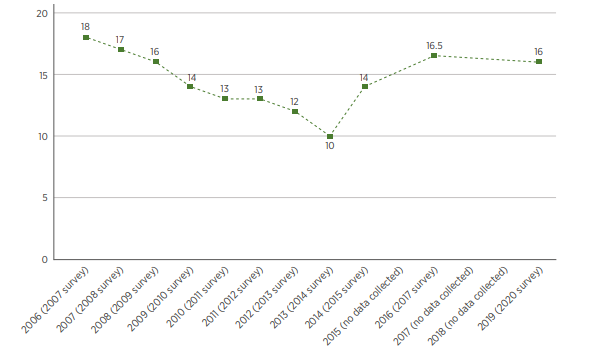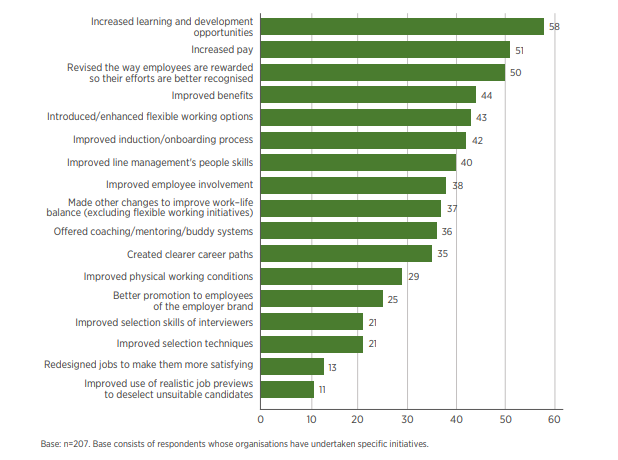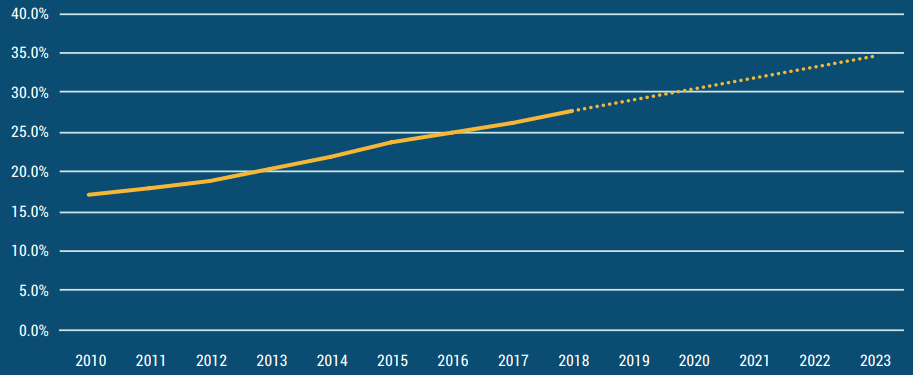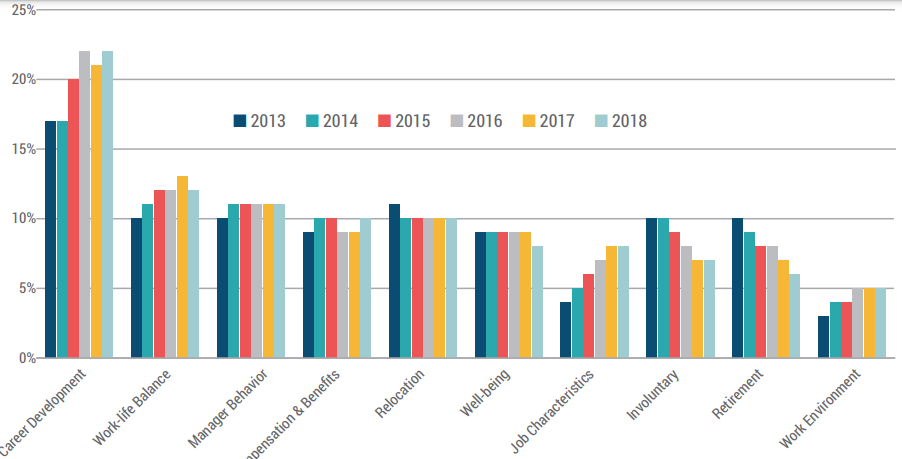Introduction
Employees are increasingly moving freely from one employer to another. According to the Work Institute 2019 Retention Report, a staggering 27 out of every 100 workers in the country exited their current workplaces in 2018. These results are confirmed by a recent Bureau of Labor Statistics (2020) report which indicated a steady increase in the total quits rate for all industries, rising from 23.7% in 2015 to 27.9% in 2019. These alarming statistics demonstrate that high turnover rates remain a serious concern in many corporate entities in the country. This report presents a critical review of a broad range of information sources to determine factors that contribute to high turnover and effective strategies for improving retention efforts.
Review Focus
This critical review focused on existing literature on employee turnover. Employee turnover is the measure of workers who quit their work over a specified period. It is attributed to multiple issues, including job dissatisfaction, poor performance, redundancy, and organizational restructuring (Rubenstein et al., 2019). The appalling cost of staff turnover informed the decision to examine this subject matter. Recent data showed that U.S. organizations losing startling $617 billion to staff quits in 2018, 78% of which were avoidable. The cost of losing one employee was estimated to be $15,000 (Work Institute, 2019). Furthermore, a CIPD survey identified other trends, including persistent skills shortages, intense war for top talent, and recruiting difficulties in key areas. These challenges provide a strong case for exploring the causes and interventions for high turnover costs.
The concern on employee turnover affects Abu Dhabi National Oil Company (ADNOC) in various ways. First, as Kim et al. (2017) note, when employees constantly leave a workplace, they affect the organizational culture. This can be either in a positive or negative light. It is prudent to point out that ADNOC has been associated with poor treatment of its employees, thereby supporting the premise that many employees leave the organization due to issues such as low pay and inappropriate working environment (Lee et al., 2017). Organizational culture is critical in the profitability and productivity of a company and its workforce. The management of ADNOC has to consider lowering their turnover by resolving some of the issues that make the staff leave in the first place. For example, issues of motivation can be resolved through both monetary and non-monetary activities. The right policies have to be incorporated into the human resource policy for this to work seamlessly.
The fast change also means that the company spends a significant amount of money trying to attract new talents. The fact that the oil and gas industry in the region has also not been recording as much profit as before due to depleting oil reserves makes it crucial for the company to lower its operating costs. The funds used to keep recruiting replacements are considered part of the operating costs (Stamolampros et al., 2019). Further, a high employee turnover also affects the depth of organizational knowledge. This type of information encompasses the firm’s way of doing things, its relationships and contacts, and even its trade secrets. When employees leave due to misunderstanding, they rarely feel the need to include the different ways they have managed to do things during their stay in their exit report.
Stages of the Research Process
There are five main stages that the research process went through. The first was the identification of the problem or topic that was to be studied. This stage was informed by personal interest, classwork, and gaps that were realized in literature. The second stage involved the identification of past studies that had been done on the topic. It is critical to note that due to technological advancements, specifically the internet, there was an extensive database of information on the selected topic. The literature review included sifting through the information to get what is needed for the study. The sources that were selected for the study had been published in peer-reviewed journals to ensure viability. It is also important to note that both studies that supported the study’s objective, and those that disagreed with it were included in the study in an attempt to provide unbiased research work.
It is essential to point out that a well-defined methodology was required to enhance the viability of the study further. Critically, both qualitative and quantitative methods were used in the studies that made up the literature review. Arguably, the same would be suitable for the study. It can be argued that one of the objectives of the study is to determine whether there is an agreement on the main elements that support high employee turnover. Critically, the researcher also sought to determine whether companies track their employee turnover rates and whether the data they retrieve affects company policy. It is prudent to point out that such data is critical in ensuring the company’s overall success.
Literature Review
Resourcing and Talent Planning Survey
The CIPD survey examined emerging trends and developments in resourcing and talent planning practices and challenges facing UK-based firms in this human resource area. The source explores HR issues, including employee attraction, recruitment and selection, retention, and staff turnover. Furthermore, it provides useful benchmarking data on fundamental areas in contemporary HR practice, including recruitment costs, staff turnover, and retention rates. Overall, the report provides nuanced insights into the root causes of job mobility and evidence-based strategies for keeping employees.

The results of the survey showed higher employee turnover rates. The median turnover rate dropped slightly unchanged between 2016 and 2019. Figure 1 shows that the turnover rate accelerated from 10% in 2013 to 16.5% in 2016 and then dropped to 16% in 2019.Less than 20% (a fifth) of entities that were surveyed reported track turnover rates. Most of the organizations (85%) experienced a hard time keeping their workforce in 2019. These results are consistent with the previous finding showing higher turnover.

The report outlines practices that organizations are putting in place to improve their retention efforts. Figure 2 illustrates that learning and professional development opportunity, compensation, reward strategies, and fringe benefits are the strongest predictors of staff retention, reported by 58%, 51%, 50%, and 44% of the participants. The report concluded that organizations need to broaden and diversify their talent pools, take a strategic approach to talent management, develop skills in-house, and leverage technology in their HR practices.
This survey used a relatively large sample, consisting of 661 HR professionals from private and public sectors, which enabled more reliable and generalizable results. Moreover, the sample was heterogeneous making possible in-depth investigation of causes and remedies for staff turnover. The online survey method guarantees higher response rates compared to face-to-face approaches, time-, and cost-efficiency, but is not immune to bias (Evans & Mathur, 2018). The structured nature of questionnaires ensures greater objectivity by reducing the risk of researcher bias but does not allow for deeper exploration because of closed-ended questions. Moreover, the report lacks a description of research methods, which impedes readers from replicating the survey findings.
Work Institute Retention Report 2019
The main reason for choosing Work Institute’s 2019 Retention Report is that the agency conducts periodic employee surveys in different industries. The researchers examined the state of the U.S. workforce, trends in turnover, and approaches for keeping employees. 37,000 workers out of the total 250,000 participants had left their organizations in 2018. The researchers used a relatively large sample, consequently enhancing the overall reliability of the results and generalizability of the findings. However, collecting and analyzing data from the large sample is costly and time-consuming. In addition, the sample is less diverse as Whites were disproportionately overrepresented (65.7%) compared to other ethnic groups (Work Institute, 2019). The large and diverse sample allows researchers to generate more reliable results. The multiple surveys generated more reliable and valid data. Data were drawn from 37,061 exit interviews, an effective method for discovering the reasons behind high turnover and ways of addressing them in the future (Spain & Groysberg, 2016). However, tense situations surrounding staff departures may inhibit employees from sharing useful information.
Conducting telephone and web interviews with a fairly large number of companies allowed in-depth examination of the research problem. Typically low-cost, spatial surveys allow follow-up questions which help capture more information and multiple perspectives (Evans & Mathur, 2018). However, the self-reported nature of the response may compromise the validity and reliability of the data since they are subject to potential bias. For example, erroneous perceptions and lack of awareness of the reasons that prompted their turnover intentions may lead to bias.
The results of the survey revealed an increase in voluntary turnover in the last several years. 27% of the U.S. workforce voluntarily parted ways with their employers in 2018 (Figure 3). The national turnover rate increased sharply by 8.3% and 88% over 2017 and 2010, respectively (Figure 4). These trends are attributed to expansion in the U.S. economy and job creation, which exacerbate competition for existing labor. These findings are consistent with the trends reported in the CIPD’s survey, which showed an increasing number of companies reporting difficulties in retaining their workforce between 2016 and 2019.

Competition trends showed a steady increase in rivalry for workers in the last several years. Figure 3 above clearly indicates that the number of unemployed workers increased gradually between 2010 and 2018, while the employment opportunities dwindled during the same period. These patterns explain the increasing competition for top talent, consequently leading to difficulties in keeping workers. These findings confirm the results of the CIPD’s survey indicating increasing turnover rates in all sectors of the UK economy.

Figure 4 highlights some of the main drivers of employee turnover. Lack of career development opportunities topped the list of causes of turnover among the U.S., followed by work-life balance and manager behavior. These results confirm previous findings by the CIPD survey, which showed learning and development opportunities as a major contributor to retention difficulties. Other primary contributors to the higher turnover rates include compensation and benefits, relocation, wellbeing, and job characteristics.

Overall, the findings of this investigation align with the specific aim and objectives of the study. The results are neatly presented in charts and graphs, with clear explanation, which facilitates reading and comprehension. Moreover, responses from exit interviews are coded and organized into relevant themes, which show signs of in-depth synthesis and accurate understanding of the research findings. Lastly, the conclusion of the survey – organizations need to invest in employee retention – is derived from the results, particularly high turnover, and increased labor competition trends.
Employee Turnover and Organizational Performance in Federal Agencies
This source reports the findings of a panel study of turnover in federal agencies conducted between 2010 and 2014. The major reason for selecting this resource is that few studies have explored causes and consequences of different types of turnover in public agencies (Lee, 2018). Unlike pure time series or cross-sectional data, repeated measurements of the same individuals over time allows the detection and measurement of statistical effects and minimizes estimation biases associated with aggregating groups into a single time series. However, making repeated observations is costly and time-consuming as it requires significant capital and human resource investments.
The results of the analysis revealed that turnover can benefit a firm. Particularly, certain turnover types, such as transfers and involuntary, can lead to improved organizational performance. These findings challenge the consistent trend in previous surveys showing that staff quits are costly to organizations. These findings illuminate the need for considering the type of turnover when making efforts to restructure a corporation, making termination decisions, or improving its performance. For instance, eliminating workers who perform poorly or engage in costly misconducts may help improve organizational performance.
Job Mobility Among Millennials: Do They Stay or Do They Go?
Organizations value incoming generations of workers, but these new cohorts have high expectations which exacerbate current high turnover rates. Millennial workers have been widely associated with a tendency to switch jobs multiple times during their career. AbouAssi et al. (2019) investigated how the perceived millennials’ job expectations affect their job mobility. This source was selected because of its focus on the millennials who account for a substantial proportion of the current workforce.
Data was collected from the National Longitudinal Survey of Youth 1997 cohort over a five-year period. The main strength of this research method is the discovery of relationships between variables and changes in the variable over time. Analyzing data collected at different intervals permits researchers to establish causation within correlation. Moreover, the research used a relatively large sample size, which leads to a smaller margin of error, more accurate mean values, a more representative sample, and generalizable results. However, longitudinal studies are relatively expensive and time consuming since data is captured over a long time frame to show relevant, long-term results. (Wang et al., 2017).
The results showed that millennial workers switch jobs within sectors rather than between industries. Job dissatisfaction attributed to low pay was found to be a primary driver of job mobility in the non-profit (AbouAssi et al., 2019). These findings confirm by the CIPD (2020) survey that increased pay is a strong predictor of employee turnover. Turnover intentions were weaker among employees who volunteer. Overall, the results of this investigation illuminate the critical role of improving job satisfaction in reducing turnover.
Factors Affecting Employee Turnover and Retention Strategies in Business Organizations
This research digest presents an extensive review of previous literature on employee turnover. The objective of this synthesis was to establish factors that contribute to job mobility in business organizations (Al Mamun & Hasan, 2017). This source was included in this review because it provides a conceptual framework which allows a nuanced understanding of the causes and factors that influence staff turnover. The main strength of the scoping literature review approach used in this analysis is the scope of sources covered. Munn et al. (2018) explain that scoping reviews “provide a comprehensive overview of the literature on a given research topic” (p. 4). The extensive synthesis of the research topic provides valuable insights for addressing the issue of high turnover rates in the company. However, scoping reviews lack a well-defined methodology, a factor that limits their replication. Besides that, the quality of studies included in these reviews is rarely assessed like in systematic reviews. Therefore, it is imperative to understand the methodological strengths and limitations of these sources before using them.
The results of the scoping review are consistent with the findings of previous studies. For instance, Al Mamun and Hasan (2017) identified pay, fringe benefits, career promotion, working environment, clear job expectations, job fit, and co-workers’ influence as the strongest predictors of voluntary and involuntary quits. Some of the factors, such as pay and fringe benefits were identified in the Work Institute (2019) report. Hiring suitable employees, retaining key workers, effective leadership, training and development opportunity, and work-live balance were suggested as effective practices for reducing turnover. These strategies are consistent with those outlined in the CIPD (2020) survey report. Reflecting on these insights can enable the management to handle pertinent issues relating to employee turnover.
Conclusion
Many organizations are struggling to retain employees with specialized skills. This issue is largely attributed to skills shortages and intensified competition for workers in the labor market. Managing employee retention is a complicated and demanding task since multiple factors influence turnover intentions, including career development opportunities, compensation, benefits, job characteristics, and others. The reviewed sources shed light on two peculiar trends on the UK job market. Despite the fact the number of vacancies dwindle and the unemployment rates are rising, people do not hesitate to change jobs causing surges in the turnover rates as well. It appears that employee retention strategies should be complex and multifaceted to be effective. The majority of surveys showed that employee retention efforts were not confined to remuneration but expanded to include professional development opportunities, fringe benefits, and work-life balance. Overall, trends in employee retention are consistent with the reasons why employees quit, though some causes are especially challenging to tackle.
Recommendations
This review uncovered several practices that are fundamental to effective employee retention. The following recommendations may help various stakeholders reduce turnover rates and improve engagement and retention of the most valued employees of the organizations. The primary stakeholders for this report include the executive management team, senior HR personnel & line managers.
Track Employee Turnover
The CIPD survey established that many organizations do not measure or track staff turnover. Moreover, the higher cost of turnover coupled with the intensified competition for top talent and persistent skills shortages provide strong justification for tracking turnover. Analyzing the nature and extent of turnover in the organization can help understand the main drivers of staff quits. Diagnosing the root causes of this problem will enable HR and management to design, implement, and evaluate data-informed strategies for reducing turnover and improving retention in ways that meet the company’s unique needs.
Develop Skills In-House
This suggestion is premised on the strong desire for learning and development opportunities. Lack of opportunities for career advancement was consistently identified as a strong predictor of turnover. The retention strategy should focus more on developing its existing workforce to overcome the current skills shortages. Improving workers’ skills and abilities will enable HR to fill positions that are hard to recruit, including professionals and specialists.
Offer Competitive Pay and Benefits
The desire for a pay rise and increased benefits emerged as a major factor that influences employees to change jobs. Chopra (2018) stressed that workers want to be compensated well in order to cover basic expenses, such as housing, food, medication, and utilities, as well as extras. In this regard, by failing to pay its workers well, the organization will be planning to lose its valued talent to its competitors.
Create Flexible Work Arrangements
The importance of flexible work schedules cannot be underestimated, especially considering that employees are increasingly exercising more control over turnover decisions. Allowing flexible work schedules will enable workers to balance their job and life responsibilities. Flexible lunchtimes, working from home, job sharing, and part-time positions will enhance job satisfaction and reduce job-related distractions, consequently increasing employee retention and lowering turnover.
References
AbouAssi, K., McGinnis Johnson, J., & Holt, S. B. (2019). Job mobility among millennials: Do they stay or do they go?Review of Public Personnel Administration, 32, 4-23. Web.
Al Mamun, C. A., & Hasan, M. N. (2017). Factors affecting employee turnover and sound retention strategies in business organization: A conceptual view. Problems and Perspectives in Management, 15(1), 63-71. Web.
Andreß, H. J. (2017). The need for and use of panel data. IZA World of Labor, (352), 1-10. Web.
Bureau of Labor Statistics. (2020, March 17). Job openings and labor turnover survey news release. Web.
Chartered Institute of Personnel and Development. (2017). The resourcing and talent planning survey report 2017 [PDF document]. Web.
Chartered Institute of Personnel and Development. (2020). The resourcing and talent planning survey 2020 [PDF document]. Web.
Evans, J. R., & Mathur, A. (2018). The value of online surveys: A look back and a look ahead. Internet Research, 28(4), 854-887. Web.
Kim, S., Tam, L., Kim, J. N., & Rhee, Y. (2017). Determinants of employee turnover intention: Understanding the roles of organizational justice, supervisory justice, authoritarian organizational culture and organization-employee relationship quality. Corporate Communications: An International Journal, 22(3), 308-328. Web.
Lee, S. (2018). Employee turnover and organizational performance in US federal agencies. The American Review of Public Administration, 48(6), 522-534. Web.
Lee, W. T., Hom, W. P., Eberly, B. M., Li, J. J., & Mitchell, R. T. (2017). On the next decade of research in voluntary employee turnover. Academy of Management Perspectives, 31(3), 2-14. Web.
Munn, Z., Peters, M. D., Stern, C., Tufanaru, C., McArthur, A., & Aromataris, E. (2018). Systematic review or scoping review? Guidance for authors when choosing between a systematic or scoping review approach. BMC medical research methodology, 18(1), 1-7. Web.
Rubenstein, A. L., Kammeyer‐Mueller, J. D., Wang, M., & Thundiyil, T. G. (2019). “Embedded” at hire? Predicting the voluntary and involuntary turnover of new employees. Journal of Organizational Behavior, 40(3), 342-359. Web.
Spain, E., & Groysberg, B. (2016). Making exit interviews count. Harvard Business Review. Web.
Stamolampros, P., Korfiatis, N., Chalvatzis, K., & Buhalis, D. (2019). Job satisfaction and employee turnover determinants in high contact services: Insights from employees’ online reviews.Tourism Management, 75(2019), 130-147. Web.
Wang, M., Beal, D. J., Chan, D., Newman, D. A., Vancouver, J. B., & Vandenberg, R. J. (2017). Longitudinal research: A panel discussion on conceptual issues, research design, and statistical techniques. Work, Aging and Retirement, 3(1), 1-24. Web.
Work Institute. 2019 retention report: Trends, reasons, and a call for action [PDF document]. Web.